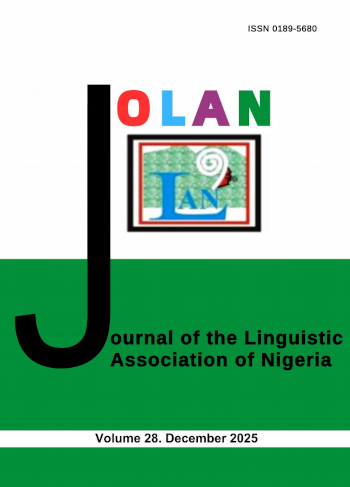Conjunctive and Appositive Functions of Òghun in the Ìlàjẹ Dialect of Yorùba
Keywords:
Ìlàjẹ-Yorùbá, òun, resumptive pronoun, pronoun stranding, appositive resumptionAbstract
Ìlàjẹ is a south-eastern Yoruba dialect. Like other Yoruba regional dialect, Ìlàjẹ preserves the native speakers’ intuition that can enhance research in Standard Yoruba. This paper provides a dialectal perspective of òun in Yoruba, by analysing òghun, (the Ìlàjẹ form for òun) as a homonym denoting a conjunction and a resumptive pronoun as well as the third person singular pronoun. The main data for the analysis came from Ìlàjẹ native speakers from Ayetoro, Ùlóghó and Ugbò communities in Ìlàjẹ Local Government Area of Ondo State. The paper employed the Phase Theory model of Chomskian Minimalist Program, though minimally explored in the phrasemakers for easier readership. The study affirms that òghun can function as the third person singular pronoun as well as a conjunction and an appositive resumptive pronoun. The antecedent of the resumptive pronoun is a topicalised nominal extracted from a focus construction. In the Focus Phrase, the topicalised nominal leaves behind a resumptive copy to be lexicalised as òghun. This happens because Ìlàjẹ cannot copy the saliency feature along with the phi features during topicalisation, in order to ensure the discourse saliency remains active within the focus construction. Therefore, this movement out of the focused position targets only the number and person features (phi features) while the stranding saliency feature in the focused position receives òghun as a mandatory default phonetic matrix. From the three functions accorded òghun in Ìlàjẹ, only the pronominal function is generally affirmed without any controversy in òun, its Standard Yoruba counterpart.
References
Adesuyan, R. A. (2018). Aro ̣́pò-orúkọ ninu e ka-èdè Ìlàjẹ. Akungba Journal of Linguistics and Literature. 9: 150-160.
Ajiboye, J. O. (2005). Topics on Yorùbá nominal expression. Ph.D. Thesis. Linguistics. Faculty of Graduate Studies. The University of British Columbia. xvi + 394pp.
Ajongolo, T. O. (2005). Negation in ÀO dialect of Yorùbá. Ph.D. Thesis. Department of Linguistics and African Languages, University of Ìbàdàn. xvi+278pp.
Awóbùlúyì, O. (1998). Àwọn e ka -èdè Yorùbá. Paper presented at Yorùbá Studies Association of Nigeria. Pastoral Institute, Bodija, Ìbàdàn. 24-26 Nov. 13pp.
Awóbùlúyì, O. (2013). Èḳ́ ọ́́Gírámà Èdè Yorùbá. Osogbo: Atman.
Bauke, L. S. (2011). Phase theory, linearization and antisymmetry in morphology. Proceedings of Language at the University of Essex. 1-5.
Chomsky, N. (2001). Derivation by phase. Ken Hale a life in language. M. Kenstowicz. Ed. Cambridge, Mass.: MIT Press, 1-52.
Chomsky, N. (2008). On phases. Foundational issues in linguistic theory. R. Freidin, C. P. Otero and M.–L. Zubizaretta. Eds. Cambridge, Mass.: MIT Press. 133-166.
Citko, B. (2014). Phase theory: an introduction. Cambridge: University Press Cambridge.
Déchaine, R. M and Wiltschko, M. (2002). Decomposing pronouns. Linguistic Inquiry 33: 409-442.
Felser, C. (2004). Wh-copying, phases, and successive cyclicity. Lingua 114: 543–574.
Frigerio, A. (2017). Demonstratives and saliency. CEUR Proceedings of the Workshop on Contexts in Philosophy Paris. Penco, C. and Vignolo, M. Eds. 48-67. Retrieved Dec. 30, 2017, from: http://ceur-ws.org/vol-1854/.
Gavruseva, E. (2000). On the syntax of possessor extraction. Lingua 110: 743–772.
Heim, I. and Kratzer, A. (1998). Semantics in generative grammar. Oxford, UK: Blackwells.
Ilori, J. F. (2004). The categorial status of òun: a Yorùbá putative conjunction. paper presented at 24th West African Language Congress (WALC) at University of Ìbàdàn. 1-6 Aug. 16pp.
Ilori, J. F. (2012). Issues on the categorial status of ‘òun’ in Yorùbá. Journal of Universal Language 13-2: 35-64.
Japhet, A. S. (2013a). The covert form of the third-person singular pronoun in Ìlàjẹ-Yorùbá. Linguistics and glocalisation of African languages for sustainable development. W. Adegbite, A. Ogunsiji and O. Taiwo. Eds. Universal Akada: Ìbàdàn. 407-425.
Japhet, A. S. (2013b). The morphosyntax of pronouns in the Ìlàjẹ dialect of Yorùbá. GRIN Verlag GmbH.: München, Germany. 141pp. ISBN: 978-3-656-48370-0
Japhet, A. S. (2017). The third-person singular object pronoun in the Ìlàjẹ dialect of Yorùbá. International journal of humanities and social science 6,10: 125-129.
Japhet, A. S. (2018). The logophoric pronoun in the Ìlàjẹ dialect of Yorùbá. Journal of Linguistic Association of Nigeria. 21, 2 159-172.
Japhet, A. S. (2020). Forms and features of personal pronouns in the Ìlàjẹ dialect of Yorùbá. PhD Thesis April 2020 draft. Linguistics and African Languages, Arts, University of Ìbàdàn. Ìbàdàn. Xvi + 208pp.
Larson, R. K. 1988. On the double object construction. Linguistic Inquiry 19, 335-392.
Szabolcsi, A. (1983). The possessor that ran away from home. The Linguistic Review 3: 89–102.
Taiwo, O. & Japhet, A. S. (2019). Personal pronouns in the Ìlàjẹ dialect of Yorùbá. Journal of West African Languages 46.2: 47- 72.
Tellier, C. (1988). Universal licensing: implications for parasitic gap constructions. Doctoral dissertation, McGill University, Montreal, Quebec.
van Koppen, M. (2012). The distribution of phi-features in pronouns. Nat Lang Linguist Theory 30:135–177.
von Heusinger, K. (2013). The salience theory of definiteness. Perspectives on pragmatics and philosophy. A. Capone, F. Lo Piparo and F. M. Carapezza. Eds. Berlin: Springer. Retrieved Feb. 02, 2018, from https://pdf.semanticscholar.org
Yuka, L. C. & Adefabi, F. (2015). The resumptive pronoun in Ṣúpárè and the high tone syllable in standard Yorùbá. Journal of Linguistic Studies 1: 87-113.
Yusuf, O. (1980). Conjunction in Yorùbá. Paper Presented at the Department of Linguistics and Nigerian Languages Seminar. University of Ilorin.














